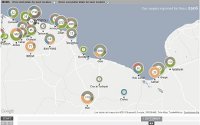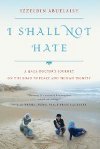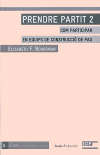Recommendations
More Recommendations
-

On violence
Hannah Arendt. Sobre la violència. Barcelona: ICIP - Angle Editorial, 2011.
Hannah Arendt was undoubtedly one of the most cogent and influential minds of twentieth century political thought, as well as one of the most prolific authors. May 1968 and the Cold War provided the political backdrop for an essay from a historical perspective. The text is imbued with the legacy of the wars and revolutions of the first half of the twentieth century. In this book, Arendt considers violence in a particularly turbulent situation, taking the non-violent social movements for civil rights that existed at the time she was writing the essay as her main reference for analysis.
The author reviews key concepts of political theory that were not sufficiently clear in the political thought of the 1970s: "It is, I think, a rather sad reflection on the present state of political science that our terminology does not distinguish among such keywords as power, strength, force, authority and finally violence". All these words suggest a means for men to dominate each other. The subtlety of Arendt's thought clarifies the differences between these concepts, and concludes that what makes violence distinctive is its instrumental nature. She also deals with political action, which she sees in terms of a manifestation that is inherent in the human condition. The network of human relationships requires a plural context in order to transcend and acquire theoretical substantiation.
Hannah Arendt sympathized with the nonviolent movement, and acknowledges rationality and emotional content when violence is exploited in order to achieve objectives that are often sympathetic to moderation and justice. Nevertheless, the author rejects the idea that violence in itself has the ability to create power and to establish political freedom.
M.L.A.
-

Women, war and peace
Women, War and Peace is a series of five documentaries which depict the situation of women in different conflict zones in the world.
In addition to being victims of conflicts and wars, women are key figures in peace and reconciliation processes. Set in four different continents, these documentaries question the traditional view of war as a "man's thing" and they are a useful tool to illustrate how it affects women.
The first episode, I Came to Testify, reports the story of Bosnian women of the city of Foca at the witness stand of the International Criminal Court, where, for the first time, violation was recognized and punished as a crime against humanity. The second, Pray the Devil Back to Hell, narrates the fight for peace by Liberian women after 14 years of civil war. The third episode, Peace Unveiled, depicts how Afghan women stand up against the Taliban. The next episode, The War We Are Living, tells the story of afro-Colombian women who fight against terror at the Cauca region. Last, War Redefined offers us a global vision by means of testimonials of several experts and victims of conflicts.
The series is available on the web site, where you can also find interviews and extra material related to these conflicts, complementing the previously mentioned episodes.
M. L.
-

Excellent infographics on NATO attacks in Libya
http://www.guardian.co.uk/news/datablog/interactive/2011/may/23/libya-nato-bombing-no-fly-zone
http://www.guardian.co.uk/news/datablog/2011/may/22/nato-libya-data-journalism-operations-country#dataNow that the NATO operation in Libya has come to an end, it's time for some retrospect. How many NATO attacks took place over Libya since the start of Operation Unified Protector in April? What was hit? How many attacks has each country been involved in? Etc.
Answers to these questions are provided by The Guardian's interactive timeline, charts, and other infographics on the NATO operation that cost millions of dollars and involved nearly 13,000 personnel from 18 countries.
The datablog, which they claim to be "the most complete breakdown of the NATO operation yet published", is particularly useful because, whereas NATO does not provide details of individual member's efforts, the Guardian also incorporates data from Member State's defence ministries and news reports.
Providing a unique insight into the division of labour of this NATO operation, it shows clearly that, while the US may have dominated the operations, with more than 8,000 personnel participating in the first weeks of the operation, the weight of the conflict has fallen on the UK, Italy, France and Canada. Moreover, it shows that the Arab states involved - Jordan, Qatar and the UAE - have been reluctant to play a significant role.
Apart from the visually highly attractive infographics you can also download the full datasets. In short, definitely worth a visit!
L.v.T.
-

I Shall Not hate
Izzeldin Abuelaish. I Shall Not hate. A Gaza Doctor's Journey on the Road to Peace and Human Dignity. Nova York: Walker & Company, 2011.
More than sixty years of conflict between Palestinians and Israelis have led to hatred almost inevitably permeating the relationship between the two peoples. In that part of the world, walls of segregation, homemade rockets, bombs and suicide attacks are now assumed to be natural and logical expressions of hatred.
In this context, which is certainly not optimistic for the construction of peace, it is surprising to hear voices like that of Izzeldin Abuelaish, a Palestinian doctor from Gaza who has devoted much of his life to building bridges between Palestinians and Israelis. His method is medicine, which forgets ethnic differences and promotes solidarity in its commitment to saving lives. His goal is to show that the frontiers between the two peoples are not insurmountable and that coexistence is possible.
Izzeldin's commitment to building these bridges, which led him to become the first Palestinian doctor working in a hospital in Israel, has encountered numerous obstacles along the way: endless humiliations and hold-ups at checkpoints when leaving Gaza; hostility from members of both communities; and above all, the loss of three of his daughters under Israeli fire during the bombing of Gaza in 2008.
Despite these setbacks, some of which are very dramatic, Izzeldin has decided not to hate, because he says that hatred is a chronic and destructive illness. Instead, this doctor is continuing his struggle to construct peace between Palestinians and Israelis - a peace that he sees in terms of human dignity, respect and dialogue. Listening to his story is therefore a recipe against the perpetuation of hatred and a small dose of hope in the search for peace in the region.
J. L.
-

Taking a stand 2
Elizabeth F. Boardman. Prendre partit 2. Com participar en equips de construcció de Pau. Barcelona: ICIP – Icaria, 2011.
This second volume of the book by Elizabeth F. Boardman continues with the didactic and pragmatic tone that was apparent in "Taking a Stand Part 1 - a guide to peace teams and accompaniment projects." This time around, the author's analysis focuses on three peace organizations working on initiatives for the construction peace on the ground. While the first volume looks at a wide range of questions and issues that a person may consider before joining a project of this type, in the second part the author looks in detail at the distinguishing features of three of the most important organizations in this field: Christian Peacemaker Teams, Voices in the Wilderness and Peace Brigades International. In a final section, the text gives a brief overview of other organizations that also undertake this type of mission.
The book, which continues the themes set out in the ICIP's "Tools for Peace, Security and Justice" collection, is highly practical. It aims to be a useful tool and this will certainly be the case. There are at least three profiles of people for whom this book will be very useful. First, people considering the possibility of joining an accompaniment and peace-building project. Second, those interested in finding out about the distinctive features and key individuals in accompaniment organizations, i.e. those who want to find out more about the peace movement in broader terms. Finally, the book will also be useful for people who cooperate or work with peace organizations in Catalonia; they will find it very useful for finding out how other organizations deal with certain problems, how to solve them and will probably be inspired to improve their own projects. All in all, this is a very practical and useful volume written in simple and straightforward prose. It is in short a useful tool.
P. A.